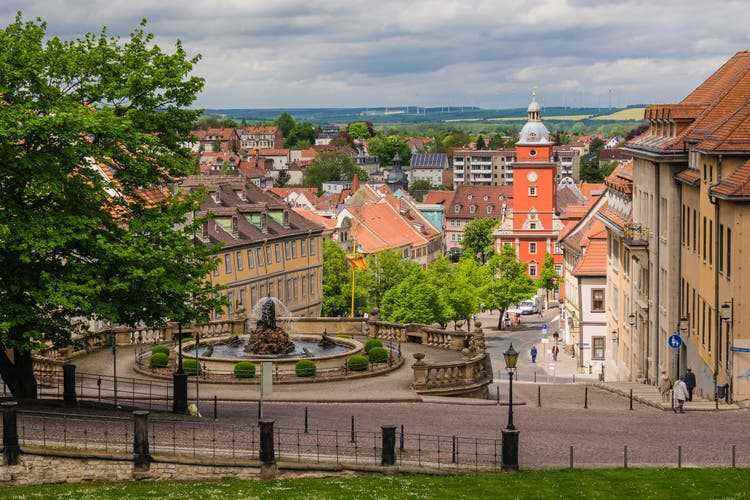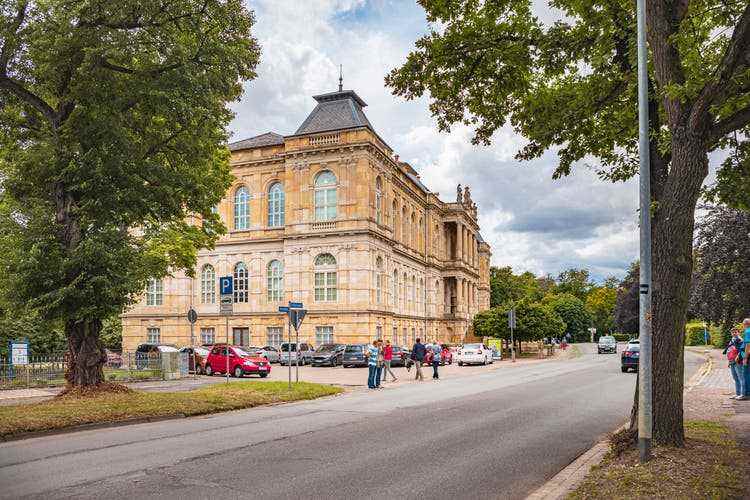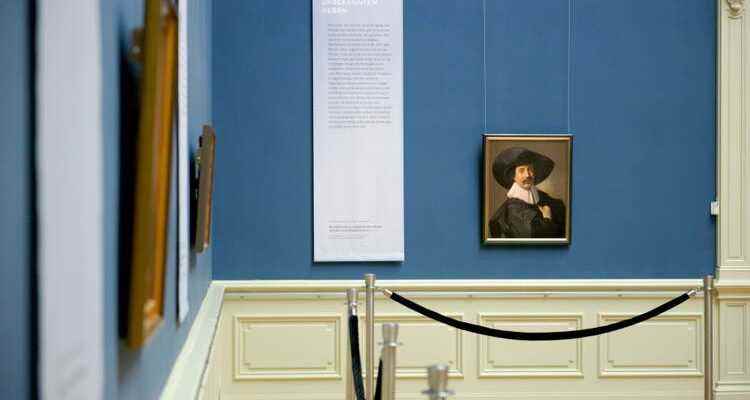It is the largest art robbery in the history of the former GDR. Its enlightenment lasted for decades up to the present.
The presentation of the five paintings from the 1979 Gotha art robbery on January 20, 2020 in the Ducal Museum in Gotha: here the “Bust of an unknown gentleman with hat and gloves” (around 1535) by Frans Hals.
On December 14, 1979, the rumor of an art theft from the Ducal Museum in Gotha, Thuringia, spread like wildfire. Five valuable paintings are said to have been stolen. And that in the surveillance state of the GDR, where everything was the property of the people. The shock and consternation in the former residential city were great when the vague news spread. Anyone who worked in the museum or in the neighboring Friedenstein Castle became a source of information. Whether on the main market, while shopping, at work or in the restaurant, everyone had heard something. The following day, the state news agency ADN confirmed the burglary.
The stolen goods included five top-class paintings, a “Saint Catherine” by Hans Holbein the Elder. Ä., a “Country road with farm wagons and cows” from the workshop of Jan Brueghel the Elder. Ä., the “Bust of an unknown gentleman with hat and gloves” by Frans Hals, a copy of the “Self-Portrait with Sunflower” by Anthonis van Dyck and the “Portrait of an Old Man” from the Rembrandt workshop.
Today’s estimated value is around five million euros. For four decades, well beyond German reunification, the loot went missing and one of the most puzzling cases of art crime remained unsolved.
The burglary
It was cold and rainy on the night of December 14th when a hygrometer inside the museum registered a drop in temperature from around 2am. An unknown perpetrator had climbed over the gutter and lightning rod on the west side of the building for almost ten meters and smashed a window on the second floor. The five masterpieces were obviously carried down with ropes, frame parts and crampons were left behind. The People’s Police and State Security reacted to the robbery with a huge contingent. One of the largest and most exciting manhunts in the socialist workers’ and farmers’ state was launched.
Numerous theses and assumptions about the motive came into circulation. Was it a contract theft? Employees of the museum, the ducal family of Saxe-Coburg and Gotha living in Coburg in western Germany, and even “Gypsies” living in the city, all came under suspicion. The Stasi itself was also suspected. It could have procured foreign currency by selling the stolen goods in capitalist countries abroad. Although the police state’s investigations were in full swing, no trace of the perpetrators could be found and the proceedings were discontinued.
Everyone agreed on one point: for the people in the GDR, as the mayor of Gotha, Knut Kreuch, said in retrospect, it was “a grab by the West” for the art of the “East”. According to the Stasi, the “generous entry regulations in transit and visitor traffic contributed to the preparation and implementation of the criminal theft”.
«Signs of life» of the works of art
As a result, the spectacular burglary fell more and more into oblivion. In the summer of 2009, thirty years after the theft, a media campaign by the city administration commemorated the event, but did not trigger any direct reactions. Completely surprisingly, even if completely secretly, things started to move again after decades. In June 2018, a lawyer from southern Germany contacted Lord Mayor Kreuch on behalf of a community of heirs and presented him with color photos of the works, which had previously only been documented in black and white. At the same time, the lawyer informed the mayor that the community of heirs was prepared to return the paintings to the Ducal Museum for a ransom of 5.25 million euros.
The negotiations demanded exceptional sensitivity from Kreuch. Since the municipality could not have raised the required sum, the mayor turned to the Ernst von Siemens Art Foundation. After the latter had promised their support, Kreuch signaled his willingness to buy to the heirs’ lawyer.

View of Gotha.
Together, after a long period of mutual “scanning”, we managed to convince the legal representatives of the providers that all five pictures first had to be technologically examined in Berlin in the Rathgen research laboratory of the State Museums and checked for their authenticity. The attorney signed the settlement agreement. From a legal point of view, it was decisive that the pictures were first handed over to Kreuch, who was chairman of the board of trustees of the Gothaer Stiftung Schloss Friedenstein, and only then to the laboratory. The research institute was not allowed to accept stolen goods. The consignor was now Gotha.
At the request of the laboratory, the State Criminal Police Office was involved, represented by superintendent René Allonge, who, among other things, had brought the forger Wolfgang Beltracchi to court in 2010 and was accompanied during the action in Berlin by a covertly operating employee of the State Criminal Police Office.
An act of revenge
The handover of the artworks took place on September 30, 2019. At the agreed time, a van with the stolen paintings drove up to the institute. During the subsequent interrogation, the driver reported that he belonged to a community of heirs of five siblings, who all received a picture from their father’s estate. However, crucial questions remained unanswered. Who stole the pictures? What was the motive for the break-in? Did the paintings play a role in a German-German exchange of prisoners? Who had brought the works from the GDR? According to the state of investigation, they got to the West in 1987 or 1988. But how?
Many clues finally led to Rudi Bernhardt, a train driver who, frustrated by state repression, was driven by hatred of “the red pigs, the party, the Stasi”. The theft of the painting was his revenge on the GDR. Bernhardt came from Schmalkalden in Thuringia, was registered with the police for “criminal and political offences” and was imprisoned in 1986 for planning to flee the Republic and then deported to West Germany. His contact with the parents of the heirs mentioned was decisive for the export of the works of art.
Bernhardt had brought his booty from Gotha to Schmalkalden. There she is said to have lain unnoticed in an attic for several years. Now he wanted to bring her to the Federal Republic. The entry stamp into the GDR dated March 26, 1988 in the passport of Bernhardt’s acquaintance, which also certifies the return to the West the following day, led to the couriers of the pictures. These had brought the stolen old masters to their apartment in Ingelheim.
The community of heirs finally recognized all of Gotha’s rights in exchange for an expense allowance. After that, nothing stood in the way of returning the five paintings. On January 21, 2020, they were received by the Thuringian Prime Minister Bodo Ramelow in Gotha.
A richly documented exhibition in the Ducal Museum is currently providing information about this spectacular case and also tells of the eventful past of a centuries-old collection, which was temporarily lost to a large extent and has now regained its historical significance.

The Ducal Museum in Gotha.
For the mayor, the shock of the art theft in 1979 was the “last tip of an iceberg of losses, sales, removals and looting of the once world-famous Gotha art collection”. There was the transport of art treasures to Coburg by the ducal family, there were the occupiers who brought looted art to Russia (but returned large parts to the socialist “brother country” in 1956/58), there were thefts and illegal confiscations.
But again and again sensational returns such as the “Gotha Lovers”, an icon of medieval art, Wtewael’s “Holy Family with John”, the Gotha Book of Hours, the ivory statuette of Augustus the Strong by Wilhelm Krüger.
The “Trauma of Gotha” has become the “Miracle of Gotha”. Nevertheless, the biggest art robbery in the GDR has not yet been completely clarified. Be that as it may, the paintings that were stolen from the Ducal Museum on the night of December 13/14, 1979 have been freshly restored and are back in their place.
«Back in Gotha! The Lost Masterpieces», Ducal Museum, Stiftung Schloss Friedenstein Gotha, until August 21. Catalog book: 29.95 euros.
Residence city of the European nobility
F. Z. Gotha was the small Thuringian residence of the ducal family of Saxe-Coburg and Gotha, who were related to almost all European dynasties. Among the historic buildings in the city, the imposing castle complex, the Ekhof Theater with baroque stage technology and the Ducal Museum built between 1864 and 1879 are particularly worth a visit. The exhibits include Masterpieces by Cranach, Rubens, CD Friedrich, Jean-Antoine Houdon and Adriaen de Vries. Other focal points are the Egyptian, antique and Asian holdings, as well as arts and crafts and fans. With the advertising slogan “Gotha ennobles”, the city reminds that it was once the place where the genealogical aristocratic encyclopedia “Gothaischer Hofkalender” was published.
